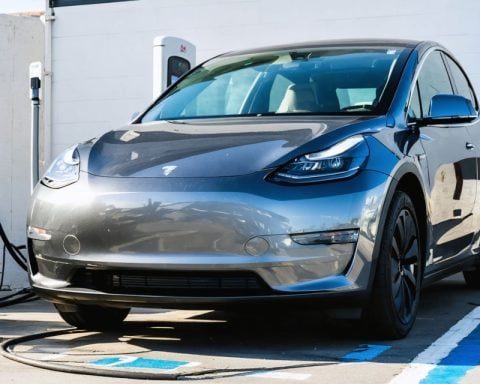- The growth of electric vehicle (EV) registrations in California has slowed significantly from past years, with only a 1% increase for 2024.
- Tesla dominates the EV market in California, holding a 52.5% share, challenging other automakers to meet the 35% state-mandated sales target for EVs.
- Consumer concerns over EV range, charging infrastructure, and costs continue to impede market growth, driving some towards hybrid models instead.
- The California Air Resources Board looks to revitalize consumer interest with investments in charging networks and financial incentives.
- The state’s ability to achieve future EV milestones is contingent on addressing current consumer hesitations and market challenges promptly.
Californians, famously eco-conscious, face an unexpected twist in the electric vehicle (EV) saga: a surprising stagnation in growth. The EV market, once charging ahead with a 46% jump, has sputtered to a mere 1% increase in registrations for 2024. With Tesla commanding a hefty 52.5% of the market, other automakers are left scrambling to hit the state-mandated 35% EV sales target. Failing to meet these benchmarks could spell penalties and restrict gasoline vehicle supplies, squeezing consumer choices and possibly inflating prices.
Consumers remain wary despite the environmental footprint reduction, citing concerns over vehicle range, charging stations, and the purchase price. These hesitations contribute significantly to the stagnation, even as zero-emission vehicles account for nearly a quarter of new car sales. The Naysayers are turning to hybrids—particularly models from Japanese automakers—over fully electric options, cementing a new trend in the market dynamics.
The California Air Resources Board remains hopeful about achieving future EV milestones but acknowledges that without reigniting public interest, the state’s sustainable transportation dreams might face delays. Innovators and policymakers alike recognize the urgency: Invest in charging networks, offer attractive financial incentives, and provide comprehensive consumer education to tip the scales back towards electric.
Key Takeaway? California’s EV ambitions hang in a precarious balance. With the right strategies, the market may rev up once more, but time is of the essence. The state must act swiftly to stoke consumer enthusiasm before its clean energy vision stalls on an uncertain road.
Electric Vehicle Stagnation: Can California Overcome Its Green Roadblock?
How Can California Overcome the Stagnation in Electric Vehicle Growth?
The sluggish growth in California’s EV market, once thriving with rapid expansion, now faces a critical period of stagnation. Several strategies could alleviate these issues:
1. Improved Charging Infrastructure: Expanding the network of fast-charging stations can help to mitigate range anxiety, encouraging more consumers to transition to EVs. Ensuring widespread, accessible charging options may prove essential for this transformation.
2. Financial Incentives and Rebates: Offering stronger financial incentives for EV purchases, such as tax rebates or discounts, could make electric vehicles more attractive compared to their gasoline counterparts. Structuring these incentives to target lower-income groups could further democratize access to EVs.
3. Public Awareness and Education Campaigns: Increasing public awareness about the benefits of EVs, beyond environmental impacts, will address misconceptions and enhance consumer confidence. Educational initiatives focusing on total cost of ownership, maintenance benefits, and technological advancements could nurture consumer interest.
Why Are Consumers Hesitant to Embrace Electric Vehicles in California?
Despite the potential for reducing carbon footprints, several concerns deter consumers from embracing EVs fully:
1. Vehicle Range Anxiety: Limited driving range remains the forefront concern for potential EV buyers. Investments in battery technology and public charging infrastructure are vital for overcoming this hurdle.
2. High Purchase Price: While EV prices are decreasing, initial costs can be prohibitive compared to gasoline vehicles. Financial products, such as loans with favorable terms, are required to make EVs more accessible.
3. Lack of Charging Stations: The scarcity of charging facilities, particularly in less densely populated areas, creates a significant barrier. Rolling out infrastructure initiatives in rural areas and along major transportation routes could enhance EV appeal.
Are Hybrids a Viable Alternative to Full EVs in California?
With the current stagnation, hybrids are increasingly seen as a viable alternative to fully electric vehicles:
1. Flexibility and Range: Hybrids offer longer ranges compared to traditional EVs, a middle ground for those concerned about running out of charge during longer trips.
2. Gradual Transition: For consumers reluctant to switch entirely to electric, hybrids serve as an introductory step towards sustainable vehicles, blending traditional fuel sources with electric technology.
3. Market Trends: The growing preference for hybrids from reputable automakers, particularly Japanese brands, could signify a pivotal shift in market dynamics, catering to those seeking environmental benefits without compromising on convenience.
California must recalibrate its strategies to meet ambitious EV targets, revitalizing consumer interest and facilitating a seamless transition to an electrified future. For further insights on the electric vehicle market and sustainability initiatives, visit California Air Resources Board and Tesla.












